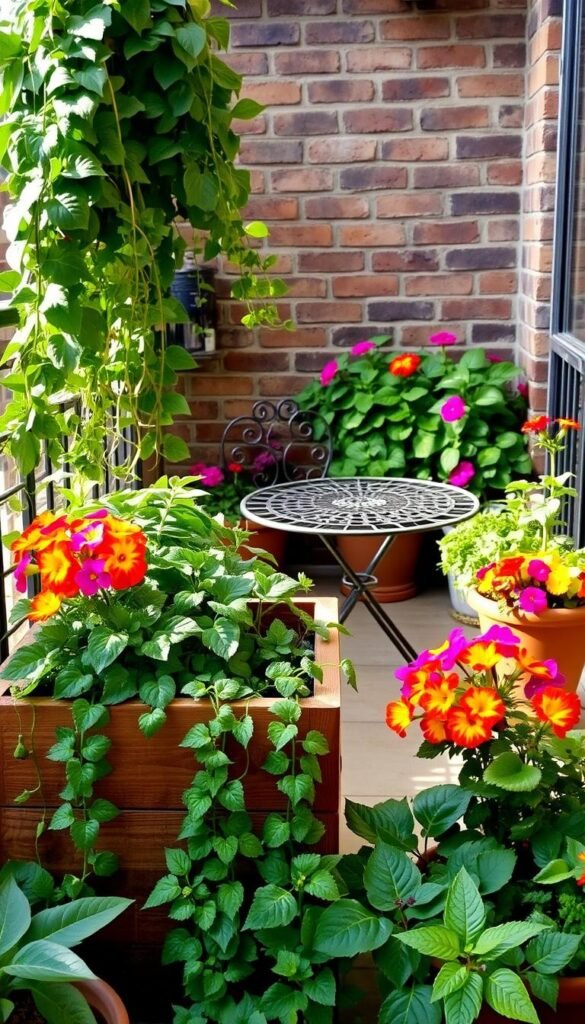Growing plants in tight urban environments might seem daunting, but it’s easier than you think to create an inviting oasis. Whether you’re working with a narrow ledge or a modest elevated platform, clever design choices can turn overlooked corners into vibrant living spaces. The key lies in strategic planning and embracing creative solutions that work with your unique layout rather than against it.
You’ll discover how vertical arrangements and multi-functional planters help optimize every available inch. Even challenging factors like weight limits or sun exposure become manageable when approached systematically. This guide reveals professional techniques used by urban growers to cultivate stunning displays in confined areas.
From selecting space-saving containers to mastering layered planting methods, we’ll explore practical approaches that add depth and character. Learn how trailing vines soften railings while compact herbs thrive in wall-mounted pockets. These methods not only maximize capacity but also create visual interest that makes your outdoor zone feel larger.
By applying fundamental principles of small-space cultivation, you’ll develop a personalized system that evolves with your needs. We’ll address common hurdles like wind patterns and drainage concerns, ensuring your green haven remains healthy year-round. Get ready to reimagine what’s possible – your dream retreat awaits just outside your door.
Inspiring Ways to Transform Your Small Balcony
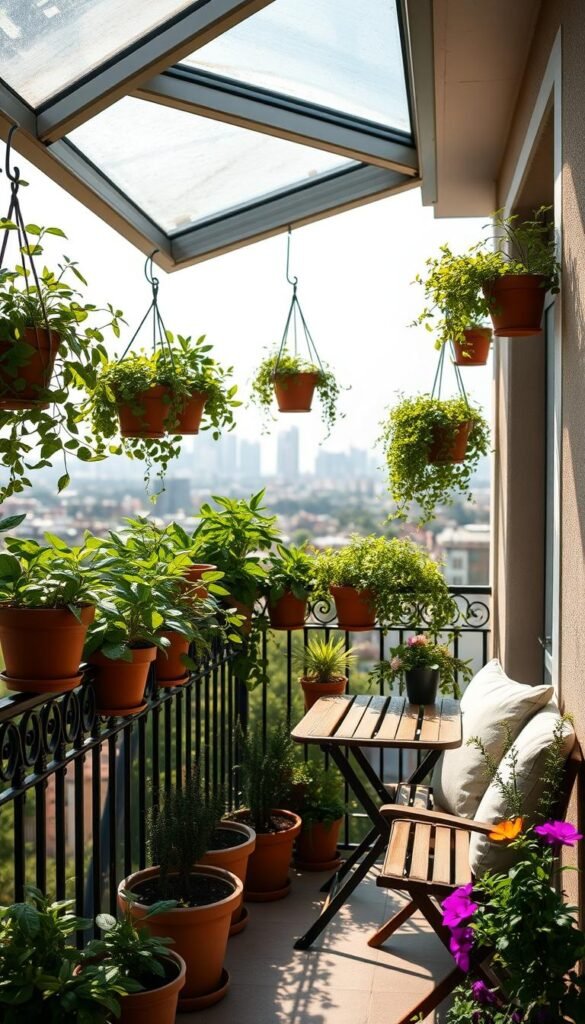
Your elevated nook becomes a sanctuary when you blend imagination with practicality. Start by asking: “What feeling do I want this area to evoke?” A cozy reading corner? A lively herb haven? Your answer shapes every decision.
Identifying Your Green Blueprint
Match plant choices to your daily patterns. Love cooking? Opt for rosemary and thyme in stackable planters. Crave calm? Ferns and ornamental grasses create soothing movement. As noted by urban growers, cohesive color schemes make tight quarters feel intentional, not cramped.
“Start with three core plants and build outward. Overplanting is the fastest way to overwhelm both your space and schedule.”
Crafting Achievable Objectives
Be honest about time commitments. This table helps balance aspirations with reality:
| Purpose | Plant Choices | Weekly Care |
|---|---|---|
| Relaxation | Lavender, Snake Plant | 15 minutes |
| Entertaining | Petunias, Dwarf Citrus | 25 minutes |
| Fresh Herbs | Basil, Mint, Oregano | 20 minutes |
Seasonal shifts matter too. Potted mums replace summer blooms when temperatures drop. Remember: modular designs adapt as your skills grow. Start with durable containers that withstand weather changes, then add specialty pieces later.
Understanding Your Balcony’s Space and Microclimate
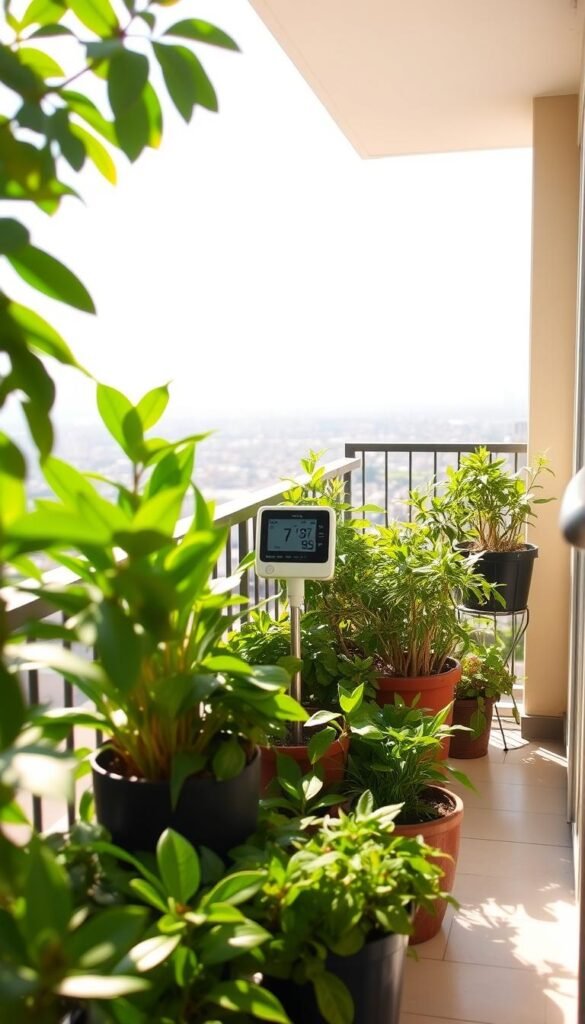
Your outdoor nook’s success starts with decoding its unique environmental personality. Like a fingerprint, no two elevated spaces share identical growing conditions. This makes planning your layout based on light patterns and airflow essential before selecting plants.
Assessing Sunlight and Shade
Track how rays move across your space over 24 hours. Morning light differs from harsh afternoon beams – some areas might get only 2 hours of direct sun. Urban structures often cast shifting shadows, creating zones where shade-tolerant species thrive. Place sun-worshipping varieties like succulents where rays linger longest, typically near railings or outer edges.
Evaluating Wind Exposure and Temperature
Notice how breezes interact with your layout. High-rise dwellers often face stronger gusts that dehydrate soil overnight. A simple test: hang lightweight ribbons to visualize airflow patterns. Concrete walls and windows can amplify heat, creating oven-like conditions. This table helps match plants to your findings:
| Factor | Observation Tips | Plant Solutions |
|---|---|---|
| Wind Speed | Check for leaning plants/debris | Low-growing herbs, ornamental grasses |
| Heat Zones | Measure surface temps at noon | Sedums, lavender, yucca |
| Shade Areas | Photograph light every 2 hours | Hostas, ferns, coleus |
Smart container gardening ideas include using privacy screens as windbreaks. These barriers protect delicate blooms while adding vertical growing opportunities. Remember: your small balcony likely has multiple microclimates – exploit these variations to expand planting options.
Choosing Containers, Planters, and Furniture Solutions
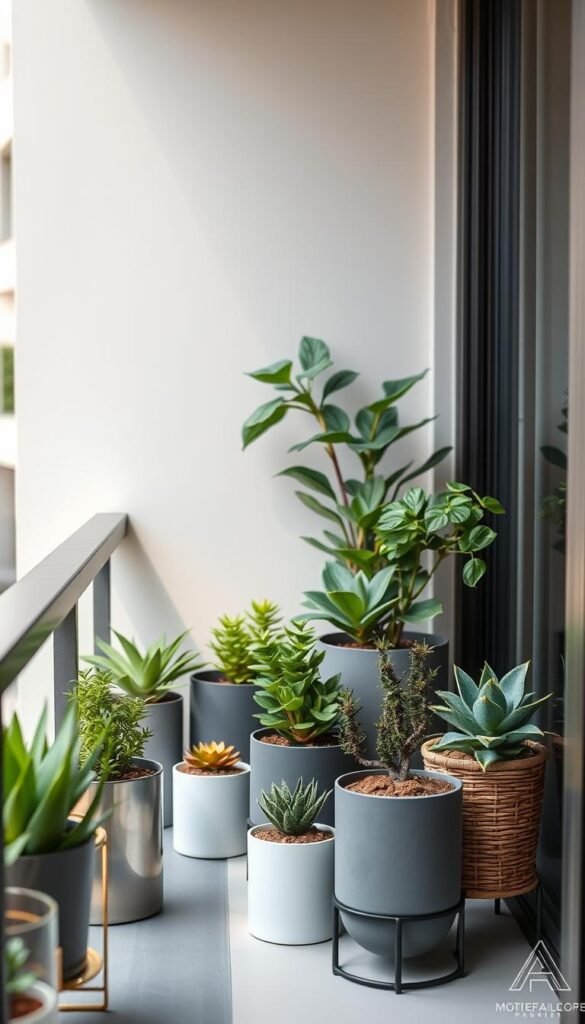
Smart container choices transform cramped areas into lush retreats without compromising safety or style. The right materials and designs ensure your setup remains practical while expressing your personality. Let’s explore how to balance aesthetics with structural realities.
Lightweight Pot Options
Plastic and fiberglass containers outperform heavy ceramics in elevated spaces. They’re weather-resistant and come in finishes mimicking stone or concrete. Fabric grow bags add flexibility – their breathable walls prevent root rot, and they fold flat when not in use.
Prioritize drainage holes and UV protection. One urban gardener notes: “My fiberglass planters survived five winters without fading – they look like aged terracotta!” Pair smaller pots with risers to create layered displays that won’t strain your floor.
Multi-functional Furniture with Built-In Planters
Benches with hidden storage compartments double as herb gardens. Side tables featuring built-in troughs let you grow trailing ivy while holding drinks. These pieces solve two problems: seating shortages and limited planting space.
Look for weatherproof wicker or powder-coated steel frames. A planter-integrated coffee table might host succulents on its surface and gardening tools below. Always check weight limits before anchoring furniture to walls or railings.
Designing a Vertical Garden for Enhanced Privacy
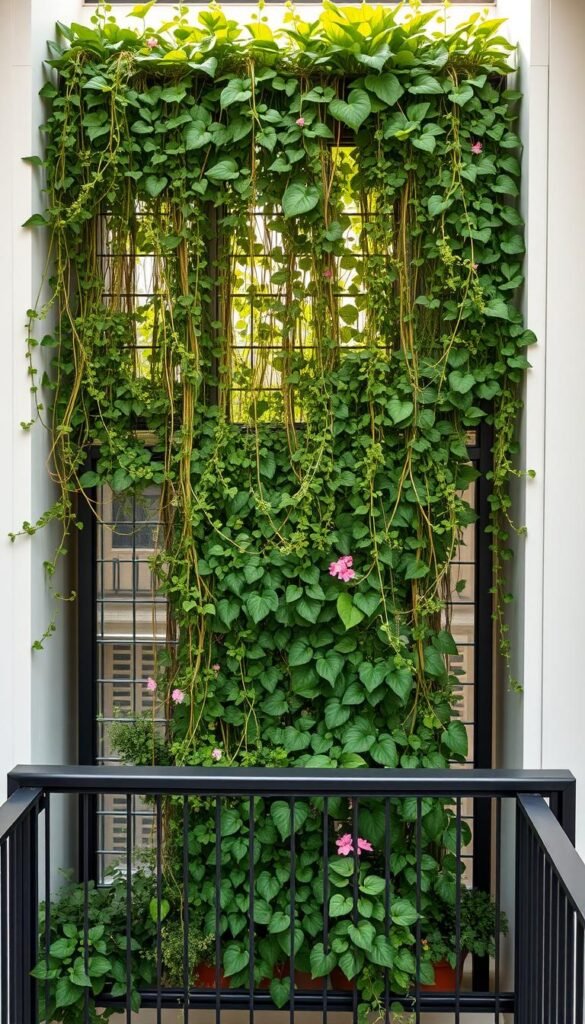
Elevating your greenery upward unlocks hidden potential in overlooked surfaces. Vertical arrangements not only conserve floor space but also craft natural barriers that shield your retreat from prying eyes. Let’s explore how to layer plants strategically for both beauty and seclusion.
Wall-Mounted Planters and Shelves
Bare walls become lush canvases with modular planting systems. Floating shelves let you arrange succulents or herbs in tiered displays, while pocket planters host trailing ivy or strawberries. Mix materials like powder-coated metal and weatherproof wood for visual contrast.
| System Type | Best Plants | Maintenance Level |
|---|---|---|
| Pocket Wall Planters | Ferns, Pothos | Low |
| Floating Shelves | Herbs, Air Plants | Medium |
| Grid Panels | Moss, Mini Orchids | High |
For inspiration on arranging these systems, explore vertical garden designs that balance form and function. Rotate plants seasonally to maintain year-round interest.
Effective Use of Trellises and Hanging Baskets
Trellises transform railings into living curtains. Train jasmine or clematis to climb wire frames – their fragrant blooms create moving artwork while blocking sightlines. Pair with hanging baskets of petunias or trailing rosemary for layered coverage.
Consider these combinations:
- Sunny spots: Bougainvillea on trellises + strawberry baskets
- Shaded areas: Climbing hydrangea + ferns in suspended planters
For windy locations, secure structures using DIY trellis projects with reinforced anchors. This dual approach maximizes privacy while protecting delicate species from harsh gusts.
10 Balcony Garden Ideas for Maximizing Small Spaces
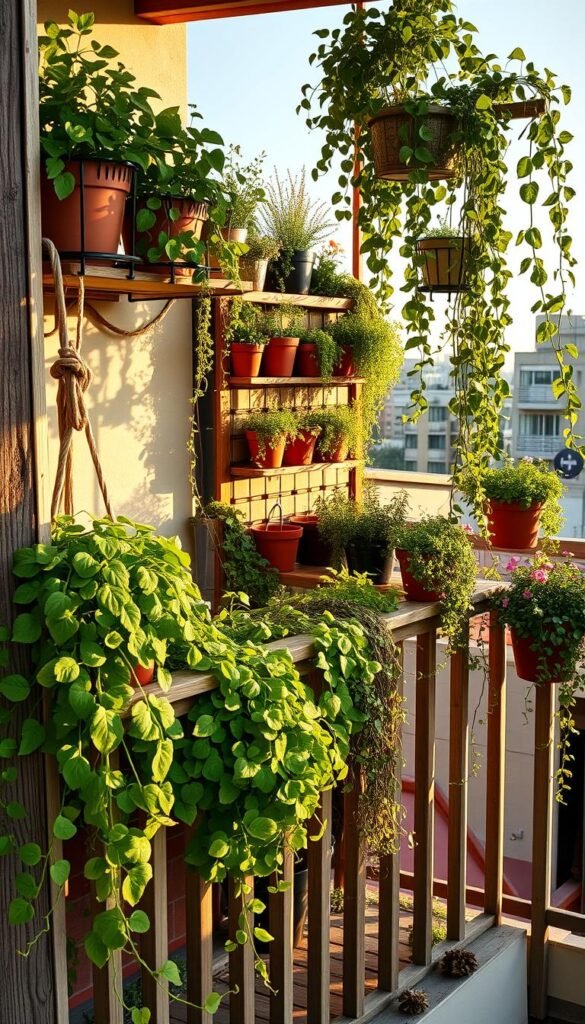
Unlocking your outdoor area’s potential starts with smart, layered designs that work smarter, not harder. Vertical arrangements like wall-mounted pockets let trailing plants cascade downward, freeing up floor space for seating or larger containers. Pair these with hanging baskets of strawberries or petunias to add depth without clutter.
Multi-level containers create visual height while housing herbs or succulents in compact setups. Try stacking modular planters or using railing troughs for mint and basil. Edible gardens thrive when you choose dwarf citrus trees or patio tomatoes bred for tight quarters.
Furniture with built-in planters solves two problems at once. A bench storing tools underneath becomes a planter for thyme, while foldable side tables with attached pots keep drinks and greenery within reach. Seasonal swaps keep things fresh – swap summer geraniums for frost-resistant kale as temperatures drop.
For year-round structure, try these combos:
- Sun lovers: Succulent wall art + rosemary in vertical pockets
- Shade dwellers: Fern-filled shelves + fairy gardens with moss
Remember: start simple. A single trellis with climbing beans teaches you about weight distribution before adding more layers. Your setup will grow alongside your skills, becoming a personalized retreat that defies square footage limits.
Mixing Herbs, Flowers, and Edible Plants for a Lively Oasis
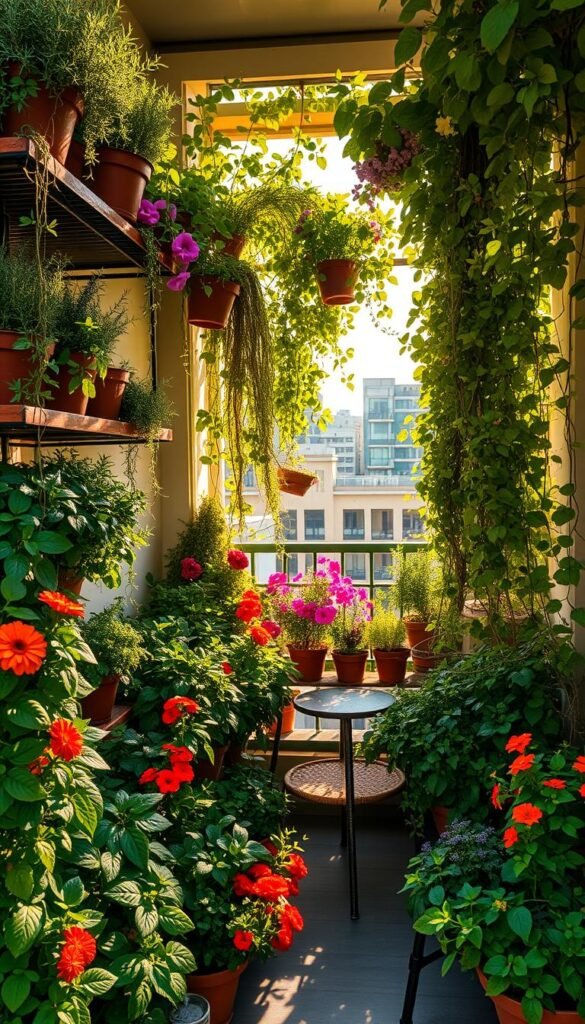
Blending flavors and fragrances transforms your outdoor area into a multi-sensory retreat. Even the tiniest ledges can host thriving combinations when you pair sun-smart herbs with cheerful blooms and productive edibles. The secret? Choosing varieties that complement each other’s growth habits while fitting your light conditions.
Selecting Dwarf and Compact Varieties
Space-conscious gardening starts with the right plant genetics. Dwarf basil grows just as flavorful as its full-sized cousin but stays under 10 inches tall. Pair it with cascading nasturtiums – their edible flowers add peppery zing to salads while brightening railings.
| Light Conditions | Plant Types | Recommended Varieties |
|---|---|---|
| Full Sun | Herbs | Lemon Thyme, Greek Oregano |
| Partial Shade | Edibles | Rainbow Chard, Mini Spinach |
| Low Light | Flowers | Impatiens, Begonias |
Urban gardener Mia Torres shares: “You don’t need a farm to grow fresh ingredients. My 4-foot ledge produces basil for pesto, chives for omelets, and marigolds to keep aphids away.”
Try these winning combinations:
- Rosemary + dwarf zinnias in terracotta pots
- Parsley + pansies in window boxes
- Cherry tomatoes + sweet alyssum in deep planters
Remember: edible flowers like calendula and borage pull double duty. They attract pollinators while spicing up your meals. Rotate crops seasonally – swap summer basil for frost-tolerant kale in fall planters.
Embracing DIY Projects: Vertical Planters and Mini Greenhouses
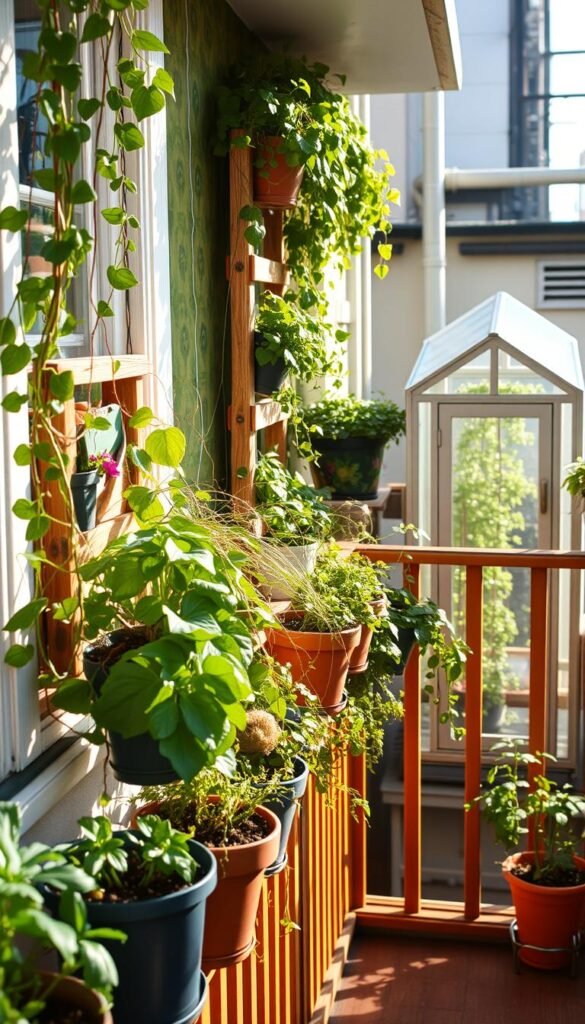
Transform your outdoor space with hands-on projects that multiply planting areas while adding personal flair. Custom structures let you grow more plants while solving unique layout challenges. Whether you’re upcycling materials or building from scratch, these solutions adapt to your balcony’s quirks.
Crafting a DIY Vertical Garden
Old bookshelves become thriving green walls when lined with waterproof fabric and filled with soil. Wooden pallets mounted vertically host herbs in their slats, while hanging shoe organizers transform into strawberry towers. The key? Match materials to your gardening goals:
| Material | Best For | Prep Time |
|---|---|---|
| Reclaimed Pallets | Succulents, herbs | 1 hour |
| Plastic Organizers | Leafy greens | 20 minutes |
| Metal Grids | Air plants | 45 minutes |
Urban grower Liam Carter shares: “My pallet garden yields enough basil for weekly pesto. The vertical setup keeps leaves clean and within easy reach.”
Setting Up a Mini Greenhouse
Extend your growing season using clear storage bins or PVC frames draped with plastic. These micro-environments protect seedlings from chilly mornings while trapping humidity for tropical greenery. For windy spaces, anchor structures with sandbags or attach them to railings.
Consider these options:
- Repurposed glass cabinets for orchids
- Zip-up greenhouse tents for citrus trees
- Plastic bottle cloches over individual plants
Adjust ventilation by propping open lids during sunny afternoons. You’ll enjoy fresh herbs weeks earlier and safeguard delicate blooms when frost threatens.
Seasonal Displays: Keeping Your Balcony Vibrant Year-Round
Your elevated retreat thrives when you embrace nature’s rhythm through seasonal shifts. By rotating greenery and blooms, you maintain visual excitement while supporting plant health. This approach lets you experiment with textures and colors that match the changing skies.
Choosing Plants for Spring and Summer Blooms
Welcome warmer months with petunias spilling over railings or geraniums in bright window boxes. Marigolds add fiery pops of orange while repelling pests naturally. Pair these flowers with compact tomato varieties or basil for edible accents. Pro tip: mix trailing lobelia with strawberries for a cascading snack station.
Integrating Hardy Options for Fall and Winter
Swap summer stars for kale’s ruffled leaves and pansies’ cheerful faces when temperatures drop. Ornamental cabbage thrives in chilly weather, offering purple-green hues. Evergreen herbs like rosemary provide structure, while cyclamen blooms defy frost. These plants withstand shorter days, keeping your balcony lively during gray seasons.
Remember: layered containers let you quickly refresh displays. Keep taller specimens at the back and seasonal fillers up front. With smart rotations, your urban garden becomes a living calendar that celebrates every month’s unique charm.

